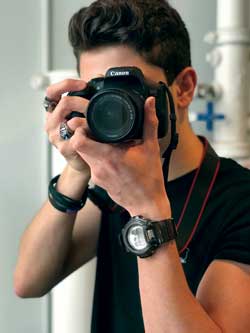Through our own lens we see the continuously changing world; we see the green leaves on trees, the blue ink of a pen, the curved shape of a cloud, and the light through a clear window, but some see the way colors and shapes fill a still frame and want that moment to be captured as it is in that moment.
A junior graphic design student, Sebastian Rebelo studies photography as a minor, says he always enjoyed taking photographs. “There’s something about capturing an exact moment in time that you can’t do with other mediums, that makes photography different. My inspiration for taking photographs has always been just for the love of taking photos. Sure, my techniques have changed as I gain experience and develop a sense of style that is unique to my photos, but I always shoot things that capture my eye and make .”
Although Rebelo’s technique has shifted due to his experiences, he still feels inspired to simply capture a moment he always know what a specific moment felt like.
Art and Design Chair and Professor, Dr. Andrew Cohen explained how photography has positively affected his life. “Photography allows me to get closer, connect in a deeper manner with people. My work focuses on transformation which I document as the mundane, unceasing human condition. I enjoy ‘street photography’ which keeps me alert to my surroundings. It requires being inconspicuous, observing the moment, and looking for the special in the mundane unfolding of the day,” Cohen revealed.
Cohen is also intrigued by documentary photography. “Over the years, and ongoing, I have documented some orphanages in Vietnam. Telling their story in a creative way is a rewarding experience. Photography opens the doors to countless stories. Telling the story is key, photographing in a creative manner, sensitive to all that is unfolding– how light adds to the moment, the composition and movements– makes the work enjoyable and keeps me going,” said Dr. Cohen.
Through Cohen’s earliest work in India, he completed his Ph.D. from University of Chicago and his book Temple Architecture and Sculpture of the Nolambas, along with other articles. “During this phase my photographic work was completely practical and not focused on the creative possibilities offered by the camera. Then, over the years in various situations, my approach to photography progressed into a creative obsession.”
Cohen explained that, although the photography was for a specific academic purpose, it went beyond passion. “Now, sensitive to light, color and movement, photography serves as my means to understand people and environment.”
Ira Wagner, adjunct Art and Design professor taught himself exposure, which involves regulating the light per unit, developing black and white film, and how to make enlargements in the darkroom.
“My interest in photography started way back in junior high school. I delivered the newspapers and saved my quarters until I could purchase a camera. I bought a Minolta (later acquired by SONY) SrT100 around 1970 which still works.” Wagner would allow students to use this camera in his black and white photography course.
Although Wagner photographed as he traveled in Europe and the western parts of the United States, photography courses widened his work exposure, helped with technical skills, and allowed him to be apart of fine art photography.
Wagner described one of his inspirations for photography as “the urban and industrial landscape.”
Similarly to Wagner’s city muse, Cohen also found the urban scene enticing. “I spent two years photographing [the change in landscape of the Bronx] and used a view camera, taking 4×5 inch color negatives,” Cohen said.
Wagner photographed the aftermath of Hurricane Sandy which was published in the National Geographic, and a book featuring his work is to be released this year. He also spoke about his most recent pieces. “Photography has become intrinsic in the way I experience the world, particularly the places I love to explore. I am currently working on several projects which allow me to be an urban explorer.”
Wagner identified qualities a photographer should have, “One needs to develop a vision and then the confidence or drive to be true to that vision. Not everyone is going to like your work. Consider the criticism but it is important to keep working even when you might feel frustrated or uninspired or even question the value of what you are doing. The reward and satisfaction has to come in doing the work.”
Erin Dolan, a sophomore graphic design student with a photography minor, noticed how photography granted her the ability to examine the world around her more closely. “Taking time and really looking at things in science, english, writing, and focusing on the details is something really important in art in searching for meaning in life.
Photography has become a part of common routines. We sip a cup of coffee and share it with the world on social media or we catch a sunrise and quickly post it for friends to see; we’ve integrated the art of photography into how we communicate with one another. If the concept of capturing an image as it is forever is more for the creative necessity than for others, then perhaps photography as a practiced art is something you should expand on.
For any new photographers, Rebelo offers some perspective; “They should take photos of thing that they like, and in time they will develop their skills and be able to take great photos.”
PHOTO TAKEN by Coral Cooper




